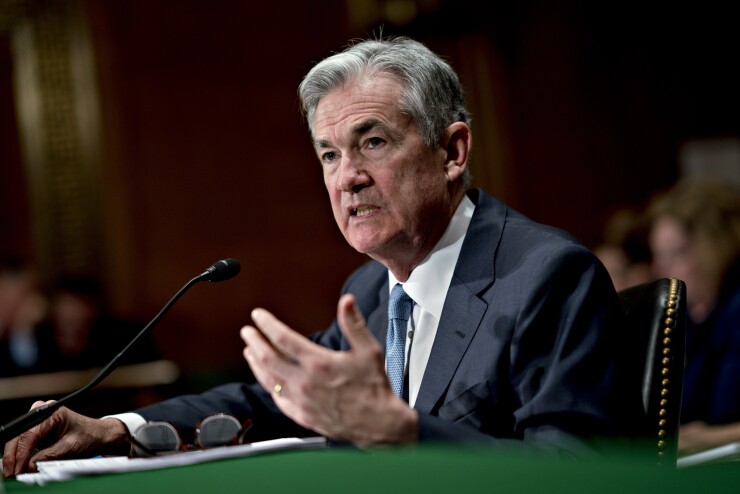WASHINGTON — The Federal Reserve Board and the Office of the Comptroller of the Currency proposed changes to the way they apply a capital backstop to the largest systemically important firms, replacing a static leverage ratio with a more dynamic ratio that takes each bank’s risk profile into account.
Members of the Fed board were split on the measure, however. Chairman Jerome Powell and Vice Chairman for Supervision Randal Quarles voted in favor, but Gov. Lael Brainard voted against it. Meanwhile, the Federal Deposit Insurance Corp., which helped drive the discussion on developing a tough leverage ratio for big banks following the crisis, apparently balked at the proposal due to the likelihood that it would lower capital levels.
"Strengthening leverage capital requirements for the largest, most systemically important banks in the United States was among the most important post crisis reforms," FDIC Chairman Martin Gruenberg said in a statement released after the proposal was issued.

In the notice of proposed rulemaking released Wednesday, the Fed and OCC suggested that the existing 2% "enhanced supplementary leverage ratio" that is applied to global systemically important banks, or G-SIBs, be replaced with a ratio made up of half of the bank’s applicable risk-based capital surcharge.
That surcharge ranges from 1% to 4.5%, though no U.S. bank has a surcharge at the top of that range. The U.S. version of the surcharge differs from the international Basel rule in that it penalizes bank reliance on short-term wholesale funding. JPMorgan Chase has the highest surcharge, at 3.5%, followed by Morgan Stanley, Citigroup and Bank of America with 3% each, though those surcharges are still in the process of being phased in.
The Fed and OCC said in a statement that the purpose of the proposal is to make the eSLR less static while also maintaining the safety of the financial system. The two agencies estimated only a modest reduction in capital allocations as a result of the rule.
“The proposed changes seek to retain a meaningful calibration of the enhanced supplementary leverage ratio standards while not discouraging firms from participating in low-risk activities,” the agencies said in a joint release. “Agency staff estimate that the proposed changes would reduce the required amount of tier 1 capital for the holding companies of these firms by approximately $400 million, or approximately 0.04 percent in aggregate tier 1 capital.”
But Brainard's opposition and the exclusion of the FDIC indicated there were divisions between the regulators on issuing the proposal.
Gruenberg's statement pointed to language in the proposal estimating that "the amount of tier 1 capital required under the proposed eSLR standard across the lead IDI subsidiaries would be approximately $121 billion less than what is required under the current eSLR standard to be considered well-capitalized.”
"Given these reductions in capital requirements, the FDIC did not join the Federal Reserve and the OCC in issuing the proposed rule," Gruenberg said.
Banks have been subject to a leverage ratio capital requirement since before the financial crisis, set at 4% of on-balance-sheet assets.
In 2013 and 2014, the three agencies wrote new joint capital rules in response to the financial crisis, including the Supplementary Leverage Ratio. That ratio requires banks with more than $250 billion in assets and/or $10 billion in overseas assets to hold 3% capital against all assets, both on and off their balance sheets. The SLR also included an enhanced Supplementary Leverage Ratio for the G-SIBs, which tacks on another 2% to the SLR, making the leverage requirement for G-SIBs 5% in total.
But Wednesday’s proposal effectively reduces the eSLR, and in the case of the G-SIBs on the lower end of the risk spectrum, reduces it dramatically. For the custody banks State Street and BNY Mellon — which have a G-SIB surcharge set at 1.5% — their eSLR will be reduced from 2% to 0.75%. Wells Fargo’s eSLR would be reduced to 1%, while Goldman Sachs’ eSLR would be reduced to 1.25%.
Brainard did not issue a statement when she dissented from the board’s vote to approve the proposal, but in a speech last week in New York, she lamented the push to reduce capital requirements at a time when the economy is already showing signs of overheating.
“At a time when valuations seem stretched and cyclical pressures are building, I would be reluctant to see our large banking institutions releasing the capital and liquidity buffers that they have built so effectively over the past few years, especially since credit growth and profitability in the U.S. banking system are robust,” Brainard said.
When the SLR rule was finalized in 2014, it was a joint effort of the Fed, OCC and FDIC. The deposit insurance agency, which does not directly oversee any of the G-SIB banks concerned, is traditionally tougher on capital regulation than the other two agencies and had pushed for a higher post-crisis capital standard for the large banks that the agencies eventually adopted.
"In April 2014, the Federal Deposit Insurance Corporation, OCC and the Federal Reserve jointly finalized a rule that required the eight U.S. GSIBs to satisfy a supplementary leverage ratio capital requirement of 5 percent at the holding company and 6 percent at their insured depository institutions," Gruenberg said. "This simple approach has served well in addressing the excessive leverage that helped deepen the financial crisis."





